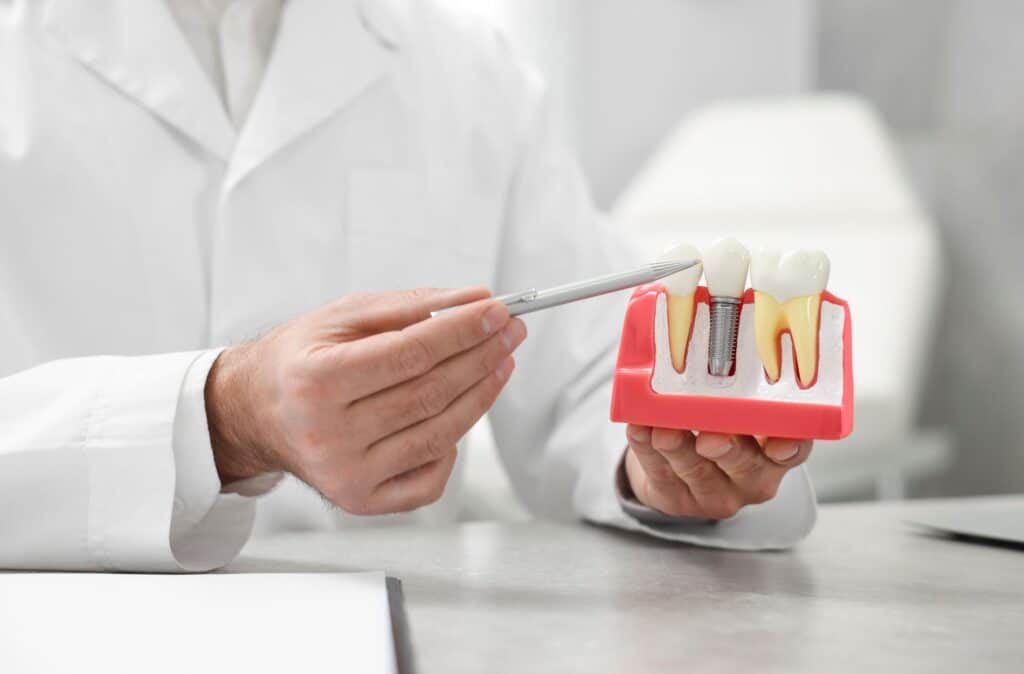Dental implants have become an excellent option for individuals looking to replace missing teeth with something permanent and natural-looking. These tiny titanium posts are embedded into your jawbone, acting like the root of a natural tooth. Over time, they integrate with the bone, providing strong support for artificial teeth and helping you maintain your natural smile.
Missing teeth can lead to more than just noticeable gaps in your smile; they can also cause problems with chewing, speaking, and even lead to bone loss over time. Dental implants address these issues by preserving the jawbone and keeping your facial structure intact.
Understanding Dental Implants: How They Work and Their Benefits
Dental implants are a popular solution for replacing missing teeth. They work by placing a small titanium post into the jawbone. This post acts like a tooth root, providing a stable foundation for the replacement tooth. Over time, the bone grows around the implant, securing it firmly in place. Then, a custom-made crown is attached to the implant, blending with your natural teeth for a seamless look.
One of the main benefits of dental implants is their durability. Since they integrate with the bone, they offer a permanent solution that can last a lifetime with proper care. Implants also help maintain the jawbone’s strength and shape. Without a tooth root, the jawbone can shrink, leading to changes in facial appearance. Implants prevent this by keeping the bone stimulated.
Dental implants improve oral health by filling gaps that can otherwise lead to misalignment of surrounding teeth. They also allow for better chewing and speaking, contributing to an improved quality of life. Plus, unlike dentures, implants don’t slip or require adhesives.
Some key advantages of dental implants include:
- Natural Appearance: Implants look and feel like your own teeth.
- Improved Oral Function: Enjoy eating and speaking with confidence.
- Bone Health: Prevents bone loss and maintains facial structure.
- Longevity: With care, implants can last a lifetime.
Steps to Prepare for Dental Implant Surgery
Preparing for dental implant surgery involves several important steps to ensure successful results. The first step is a comprehensive evaluation by your dentist. During this assessment, the dentist will take X-rays and 3D images to assess the condition of your jawbone and teeth. This helps determine if you have enough bone to support an implant or if a bone graft is necessary.
Once the evaluation is complete, your dentist will discuss a treatment plan with you. This plan outlines the steps of the procedure and timelines for healing. It’s important to address any questions you have during this meeting.
Before the surgery, your dentist will give you specific instructions to follow. Here are some common preparations:
- Review Medical History: Inform your dentist about any health conditions or medications you are taking.
- Arrange Transportation: Depending on the type of sedation used, you might not be able to drive home, so arrange for someone to take you.
- Fasting Instructions: You may need to fast for several hours before the procedure, particularly if sedation will be used.
- Wear Comfortable Clothing: Dressing comfortably can help you feel at ease during the appointment.
During this time, it’s helpful to prepare your home for post-surgery recovery, arranging items like soft foods and ice packs. These preparations help ensure a smooth surgery and a faster return to daily activities.
What to Expect During the Implant Procedure
During the dental implant procedure, it’s important to feel prepared and relaxed. The procedure typically begins with local anesthesia to numb the area where the implant will be placed. This ensures you remain comfortable and feel minimal discomfort during the process. Depending on your needs, sedation options are also available to help you feel even more at ease.
The dentist starts by making a small incision in your gum to expose the jawbone. A small hole is drilled into the bone meticulously to create space for the implant. The titanium implant is then inserted into this hole, acting as the new root for your artificial tooth. Once the implant is secured, the gum is stitched back together.
The procedure can take anywhere from one to two hours, depending on the complexity and the number of implants being placed. If necessary, bone grafts may be completed during this phase to ensure the bone can support the implant properly. After the surgery, you may experience slight swelling or discomfort, similar to other dental procedures, but these symptoms are manageable with prescribed pain medication.
Healing begins immediately following the procedure, but the implant needs time to fuse with the bone in a process known as osseointegration. This can take a few months. Your dentist will schedule follow-up appointments to monitor the healing process and ensure everything is on track. Once osseointegration is successful, a small connector post called an abutment is attached, and the custom-made crown is placed, completing the restoration and bringing your smile back to its full function and appearance.
Aftercare and Recovery: Ensuring Long-Term Success
Proper aftercare is crucial for the success of dental implants. Right after your procedure, it’s normal to have some minor bleeding, swelling, and discomfort. These side effects usually diminish within a few days. To manage discomfort, over-the-counter pain relievers or medication prescribed by your dentist can be used.
Following the post-operative instructions provided by your dentist is essential. Keep the area clean using a gentle rinse of warm saltwater several times a day. This helps reduce swelling and prevent infection. Avoid hard or sticky foods for the initial few weeks and focus on a diet of soft foods to protect the new implant site.
Good oral hygiene is key to ensuring the longevity of your dental implants. Brush and floss as advised by your dentist, but take care around the implant site initially. Scheduling regular dental check-ups will help monitor your implant’s health and maintain overall oral hygiene.
Avoid smoking and excessive alcohol consumption, as they can interfere with healing and osseointegration. By following these guidelines and adopting healthy lifestyle habits, you’ll give your dental implants the best chance for long-term success and functionality.
Conclusion
Dental implants present a strong, dependable solution for replacing missing teeth, offering both functionality and aesthetics. Understanding the process from preparation to recovery can make the experience smoother and less intimidating. With the proper care and attention following the implant procedure, you can achieve a successful and lasting result. Implants not only restore your bite and smile but also preserve your jawbone and prevent other dental complications.
At Pickering Dental Services, we understand the importance of feeling comfortable and informed throughout your dental journey. Book a consultation with us to explore how dental implants in Pickering can meet your needs and restore your smile. Let our team of experienced professionals guide you in achieving optimal dental health with personalized care and attention!



